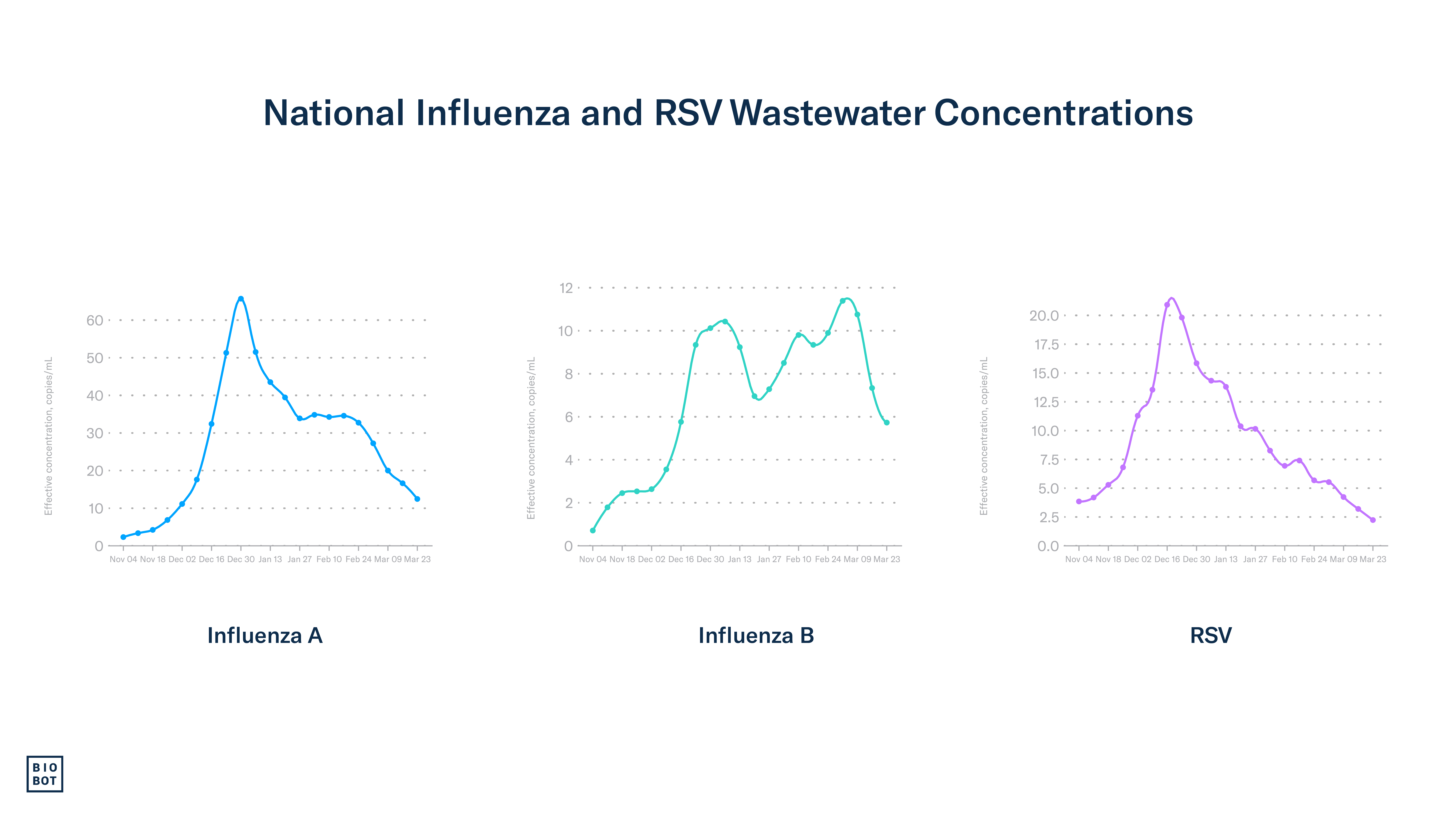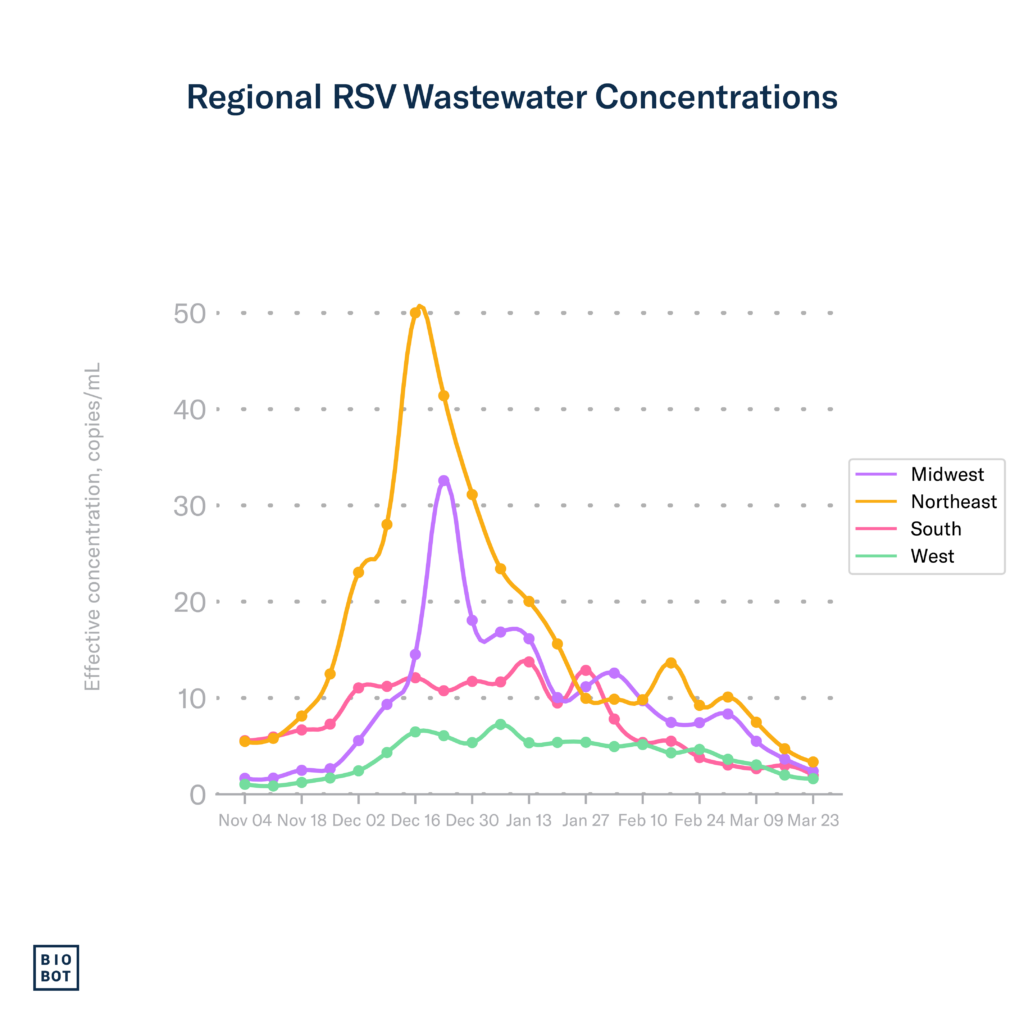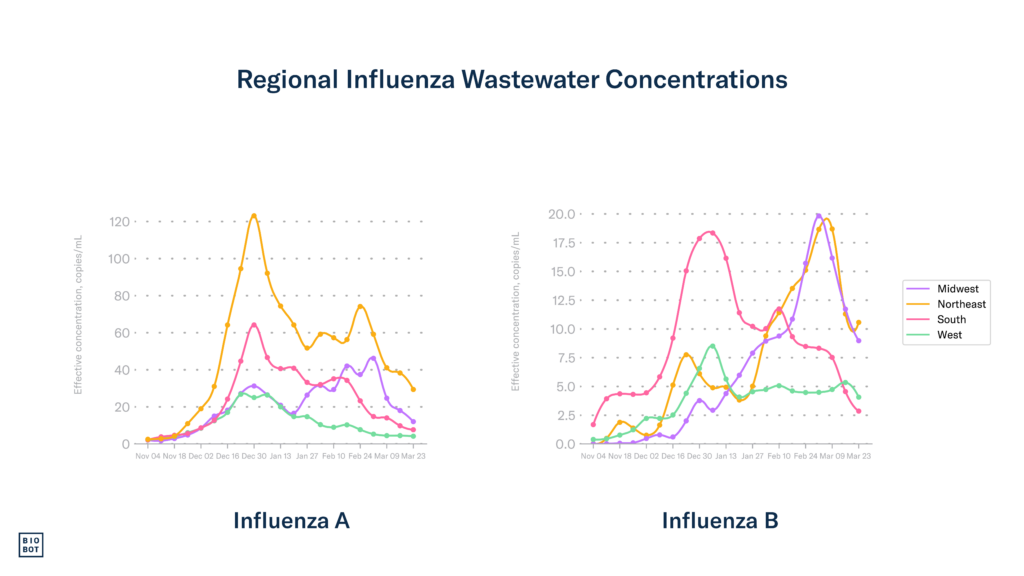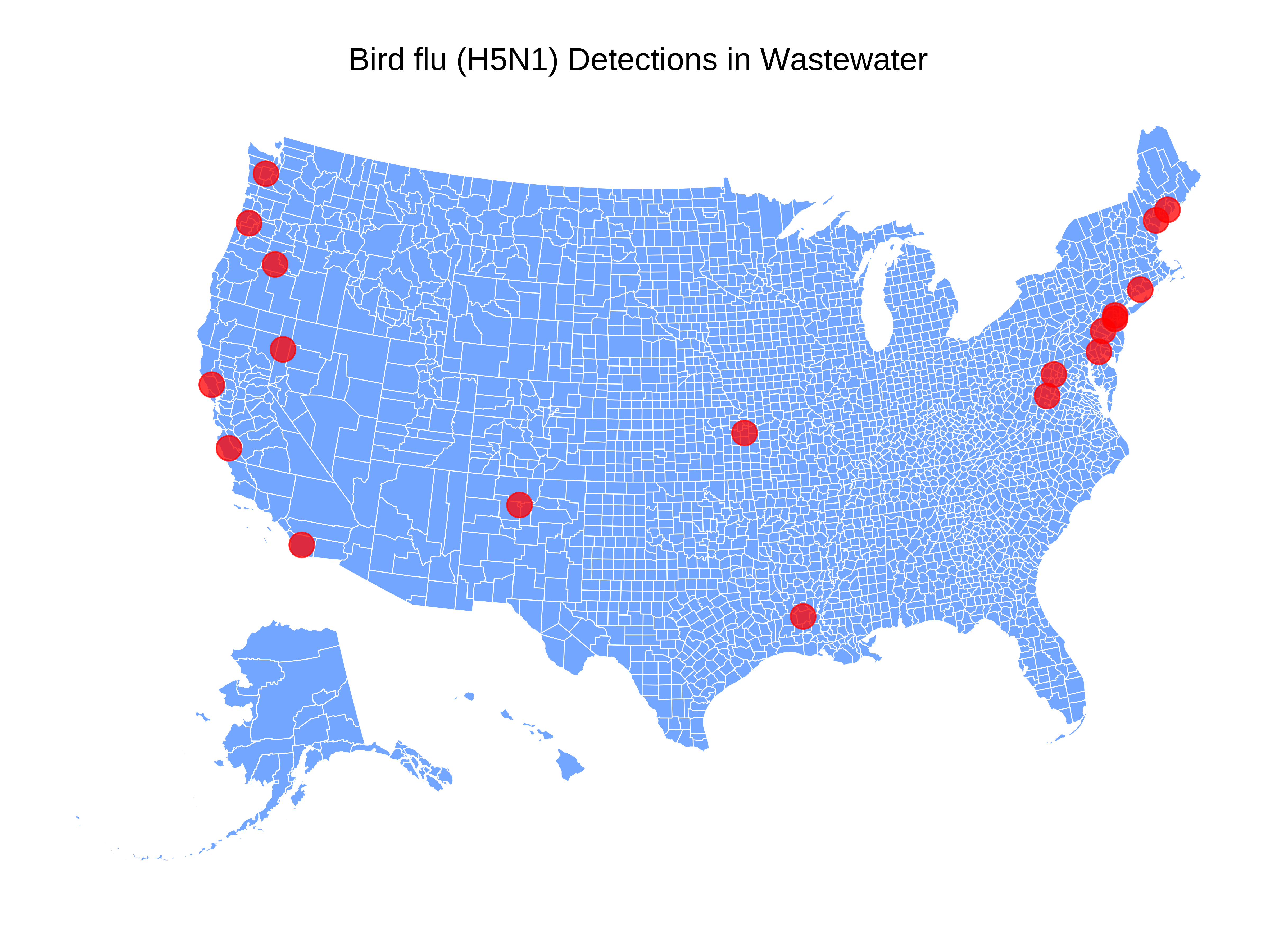At Biobot, we analyze wastewater across the country for various infectious disease pathogens....

Respiratory Virus Risk Reports
Comprehensive Insights for COVID-19, Influenza, and RSV
COVID-19, Influenza, and RSV Wastewater Wastewater Monitoring in the U.S. | Week of March 25, 2024
This respiratory season, we are analyzing wastewater for the presence of respiratory syncytial virus (RSV) and influenza virus (types A and B). Together with COVID-19, these three pathogens are outsized contributors to our seasonal respiratory illness burden. In this data series, we’ll guide you through the wealth of data we’ve gathered from our Biobot Network of national sampling sites, aiming to shed light on emerging trends in respiratory virus activity and community viral load. Our goal is to equip you with information to make informed decisions, especially as we approach the holiday season and gather with family and friends.


Data Note: Samples are collected from participating locations and processed by our lab team on a rolling basis. Each point on the figure represents the weekly average concentration from Sunday – Saturday (corresponding to the MMWR week), aligned to that week’s Saturday.
Contributors

Marisa Donnelly, PhD
Public Health Partnerships Epidemiologist

Max Imakaev, PhD
Data Scientist
Previous Risk Reports
Summary: Week of 3/25/24
In great news this week, data from Biobot’s national wastewater network and clinical disease monitoring show that COVID-19, RSV and influenza A & B activity are all declining. National average wastewater concentrations for SARS-CoV-2, RSV, and influenza A & B declined in week 12. Nationally, all major clinical metrics for COVID-19 and influenza showed signs of declining illness burden, and clinical metrics for RSV showed that the burden remains quite low. While the respiratory season isn’t quite over, we are finally starting to see lower activity levels for all three major respiratory illnesses.
The Bottom Line: As we approach the end of the respiratory virus season, viral transmission and circulation are still ongoing. It is important to reduce contact with others if you are feeling ill, consider wearing a mask in crowded environments, and keep up to date with vaccines and boosters. These measures can help keep you and your loved ones healthy.
National Outlook
RSV
National RSV wastewater concentrations continued declining during week 12 (through March 23rd), and are now at the lowest levels we’ve observed since we began RSV testing in late October.
National clinical RSV metrics remained low during week 11 (through March 16th). The percentage of positive PCR tests (test positivity) for RSV held steady, going from 2.7% the previous week to 2.4% in week 11. These test positivity levels are similar to what we observed in late September at the beginning of the respiratory illness season, signaling that current RSV test positivity is low. Hospitalization rates also continued to decline nationally and for all age groups.
While it’s likely that low levels of RSV will continue to circulate, we feel comfortable saying that RSV is at the end of its season. We will continue to report on RSV wastewater concentrations, however, this will be the last report in which we include information on clinical RSV data, unless something of note occurs.

Influenza
Influenza A and B wastewater concentrations continued to decline in week 12, going down 24.7% and 21.9%, respectively, compared to the previous week. This recent data confirms that we have passed the seasonal peak for influenza B, which is great news.
Clinical data continues to track well with influenza wastewater concentrations, as all the major clinical influenza metrics decreased in week 11. The number of hospitalizations decreased, with about 7,000 hospitalizations due to flu. The percentage of outpatient visits for influenza-like illness (ILI) – typical in flu, RSV, and COVID-19 patients – decreased from 3.7% to 3.4%. Test positivity from clinical labs decreased in week 11, going from 15.4% to 12% currently.

COVID-19
Wastewater data show that COVID-19 activity and community viral load decreased the previous week. As of week 12, the national SARS-CoV-2 wastewater concentration average is 375 copies/mL.
The declining trends we’re observing in wastewater track well with trends in clinical COVID-19 data, which continue to show that the clinical burden due to COVID-19 is declining. All the major national clinical COVID-19 metrics either declined or remained steady during week 11. COVID-19 hospitalizations dropped from around 13,400 in week 10 to just over 10,700 in week 11. The national COVID-19 test positivity rate declined from 5.2% in week 10 to 4.6% in week 11. Deaths due to COVID-19 remained steady, and currently represent 1.8% of all deaths in the US. This is all good news.
Regional
The South
RSV: In the South, RSV wastewater concentrations decreased in week 12 and are now the lowest concentrations we’ve observed for the region since we began sampling. RSV test positivity remained steady in the South during week 11 at 1.7%. These are similar levels to what was observed in the South in August, confirming that RSV activity is currently very low.
Influenza: The South continued to experience decreases in both influenza A and B wastewater concentrations during week 12. Following declining trends in wastewater concentrations, all states in the South experienced a decrease in outpatient visits due to ILI in week 11. The number of states with High ILI levels also decreased, with only one state remaining at the High level (Arkansas) and the District of Columbia remaining at a Very High level. Influenza activity appears to be low in the South and continues to decline.
COVID-19: SARS-CoV-2 wastewater concentrations declined in the South during week 12 at 329 copies/mL. The great news is that all states in the South have reported a decrease in hospitalizations due to COVID-19.
The Midwest
RSV: RSV wastewater concentrations continued to decline in the Midwest during week 12 and are currently at levels we observed in late November. Test positivity during week 11 also declined, currently at 3.1%. While RSV activity has lingered in the Midwest longer than in some regions, these declining trends are good signs that the Midwest continues to get closer to the end of its RSV season.
Influenza: Influenza A and B wastewater concentrations declined in the Midwest during week 12. While most states in the Midwest experienced decreased outpatient visits due to ILI, Wisconsin, and Iowa experienced small increases, and North Dakota and Kansas held steady from the previous week. Three states (Iowa, Ohio, and Michigan) remain in the High ILI activity level, with all other states at Low or Moderate levels. Despite these fluctuations, it still appears that flu activity continues to decline in the Midwest, although at a slightly slower rate than other regions.
COVID-19: After a brief increase, SARS-CoV-2 wastewater concentrations began decreasing again in the Midwest during week 12, currently at 433 copies/mL. During week 11, most states in the Midwest experienced a decrease in COVID-19 hospitalizations, with only two (Nebraska and Ohio) experiencing small increases. In general, and despite these small fluctuations, the Midwest continues to head in the right direction toward decreasing COVID-19 activity.
The Northeast
RSV: RSV wastewater concentrations in the Northeast continued declining during week 12 and are currently at the lowest levels we’ve observed since we began sampling. RSV test positivity also declined during week 11, currently at 1.2%. RSV activity remains quite low in the Northeast.
Influenza: The Northeast experienced decreases in influenza A and B wastewater concentrations during week 12. In sync with downward trends in wastewater concentrations, all states in the Northeast experienced a decrease in outpatient visits due to ILI during week 11. The number of states in the High ILI level also declined, with only one state (New Jersey) remaining in the High level.
COVID-19: SARS-CoV-2 wastewater concentrations declined in the Northeast during week 12, currently at 499 copies/mL. Most states in the Northeast also experienced declines in COVID-19 hospitalizations, except Maine and Massachusetts, which experienced no change in hospitalizations during the previous week.
The West
RSV: RSV wastewater concentrations continued to decline in the West during week 12 and are currently very low. RSV test positivity also declined in the West during week 11 and is currently at 2.1%. RSV activity remains very low in the West.
Influenza: Wastewater concentrations for influenza A remained stable and low in the West during week 12 and are at similar levels to those observed in late November. Following a brief increase, influenza B concentrations decreased again during week 12. The rate of decline in clinical flu metrics has appeared to slow in the West, with most states holding steady in the proportion of outpatient visits due to ILI in week 11 compared to the week prior. While Wyoming experienced a big decrease in outpatient visits due to ILI, Oregon, Utah, Montana, Nevada, and Alaska experienced increases. In good news, though, only New Mexico remains at the high ILI activity level. Despite these fluctuations, most states in the West are still at relatively low levels of flu activity, and we anticipate that activity will continue to decline.
COVID-19: After a brief plateau, SARS-CoV-2 wastewater concentrations began declining again in the West during week 12, currently at 218 copies/mL. Most states in the West also experienced decreases in hospitalizations due to COVID-19. Exceptions to this include Wyoming, Idaho, and Oregon, which experienced increases.


Footnotes:
Wastewater data from Biobot Analytics for RSV, influenza, and SARS-CoV-2 are through March 23, 2024 (MMWR week 12). Clinical data on testing, hospitalizations, and emergency department visits for RSV, influenza, and COVID-19 are from the Centers for Disease Control and Prevention. Updates to clinical data for RSV, influenza, and COVID-19 are through March 16, 2024 (MMWR week 11).






